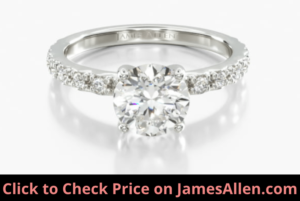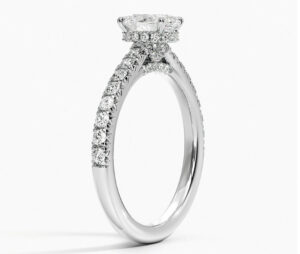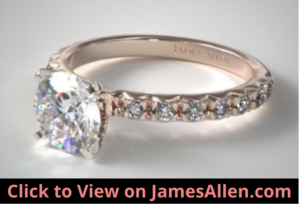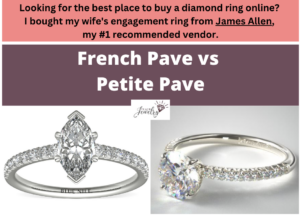
Pave settings include small diamonds lining the ring to enhance its sparkle.
There are many designs within this type of setting, but two of the most popular are French and petite pave.
The main difference between them is French pave diamonds sit in V-shaped cutouts in the ring. Petite pave is named after the small size of the prongs used to hold the accents on the shank. Both enhance the jewelry’s brilliance from every angle.
Let’s compare French versus petite pave settings, including an overview of each, three differences, and similarities they share, so you’ll know which is right for you.
What is a French Pave Setting?
French pave settings, also called “fishtail pave,” feature diamond accents placed into V-shaped grooves along the shank. The purpose is to expose more of the pavilion to light and increase brilliance.
Diamonds are wedged inside the cutout so prongs don’t block all the light.
It presents the illusion of a continuous row of accents because there’s less metal between each small diamond. It’s like the ring itself is made of them.
You can see the V-shaped holes in this engagement ring from the vendor where I bought my wife’s engagement ring.
On their website, rotate the image 360 degrees so you can view it from every angle. It’s from the profile that the V-shaped cutouts are most apparent.
There are seven small diamonds cascading down each side of the shank. Grooves rise to hold the accents in place and fall to expose the pavilion, creating the French pave design.
When you twirl the piece, diamonds in a French pave setting add more glimmer.
It’s one technique buyers use to improve sparkle without increasing the size of the main diamond, which is often far more costly.
The French pave diamonds instead complement the main one.
What is a Petite Pave Setting?
Petite pave settings mimic traditional pave. The difference is the size of the prongs that hold the diamonds.
Classic pave settings feature prongs that cover much of the small diamond, but petite pave settings solve this problem by using small prongs.
The diamond is more visible and able to better capture and reflect light, which adds brilliance to the piece.
For example, here’s a petite pave diamond engagement ring from James Allen.
Notice the grooves are smaller compared to the French pave, but the diamonds on the shank are held in place by tiny prongs.
Petite pave is often confused with micro pave.
The difference is micro pave settings use diamonds that weigh less than 0.01 carats. The ones in petite pave are small, but it derives its name from the size of the prongs and not the accents.
This type of setting is another way to enhance the glimmer and total carat weight of a ring without the costs associated with a larger center diamond.
It’s why some buyers choose pave settings over solitaire.
How are French and Petite Pave Settings Different?
1. French Pave Settings Often Hold Larger Diamonds
Larger diamonds on the shank increase the total carat weight and sparkle of the ring.
French pave settings can often hold larger diamonds more securely because of how they’re placed in the V-shaped cutout.
Check out the French pave setting below that holds a round cut at its center and on the shank.
The pavilion of each accent is held in place by grooves and in four places around its table. This prevents one of the most common problems with pave settings, where the accents are dislodged from the shank of the ring.
On the other hand, the miniature prongs on petite pave settings limit the size of diamonds it can hold. petite pave settings feature diamonds held in place by tiny prongs.
The upside is prongs don’t block them from view.
Whether you choose French or petite pave, you’ll be dealing with small diamonds, but the ones in a French pave setting may have a higher carat weight.
2. Fewer Variations of Petite Pave
Petite pave settings have fewer variations than French pave. The petite pave design is simple.
Tiny prongs hold diamond accents along the shank, whether halfway down both sides or all the way around in an eternity setting.
There are several types of French pave that each have a distinct aesthetic.
For example, the Neo-French pave includes designs similar to a U-cut setting, but the difference is the shape of the cutout.
Here’s a close-up view of that design, and I’ve pointed to the cutout.
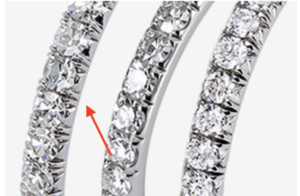
It starts by resembling a U shape, but there’s additional etching along the metal walls, and the bottom is pointed to form a V.
This vintage style can also feature two or three rows of pave diamonds.
Then there’s the Delicate French pave.
The common design element is the V-shaped grooves that hold accents, but within this category, there are plenty of options.
I recommend exploring online jewelry vendors, because they tend to have a wider selection of settings compared to brick-and-mortar locations.
3. French Pave is Labor Intensive
Creating a French pave diamond ring setting is more labor intensive than petite pave. Etching intricate cutouts to hold accents is a precise process with little room for error.
If holes are too large, diamonds will fall out. If they’re too small, the designer will have to find smaller diamonds to fit.
Petite pave settings are less complex. Small prongs are placed on the shank to hold each diamond.
This is why French pave settings are often more expensive than petite pave.
For example, this petite pave engagement ring is listed at $742.
As a comparison, the ring below with a French pave costs $907.
You can find some exceptions.
For example, a petite pave setting in platinum is often more expensive than a similar design in 14k white gold.
Like most decisions related to buying a diamond ring, it’s about weighing which traits are most important to you.
Are There Similarities?
1. Improve Brilliance
Their goals are to improve brilliance. Specifically, the ring won’t only sparkle on top from the center diamond but will have this effect at multiple angles.
This is an effective technique if you’ve chosen a step-cut diamond in the middle.
To illustrate, let’s say your center diamond is an emerald cut, which is known to produce a soft glow instead of strong white light.
By adding round-cut diamonds as part of a petite or French pave setting, you’ll compensate for the lack of light performance from the emerald cut.
The brilliant cut diamonds on the shank complement the step-cut in the middle.
2. Difficulty Resizing
The two types of pave make resizing the ring a difficult process.
French pave settings have such intricate detail and precise grooves.
As an illustration, check out the setting below, and imagine the challenge of reducing or increase its size when there are so many diamonds to factor.
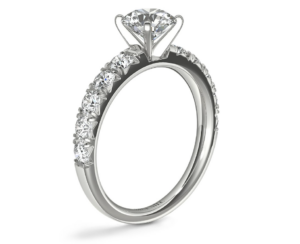
Jewelers aren’t often able to cut out a small piece and solder it back together because it would undo the V-shaped cutouts.
The small prongs on petite pave settings cause a similar problem for resizing.
Always have certainty about the size of your ring before choosing a style of pave.
3. Variety of Metals
Lastly, French and petite pave settings come in a variety of metals. The most popular are:
- White gold
- Rose gold
- Yellow gold
- Platinum
Most online jewelry retailers, like sell rings in all these types and more, so you aren’t limited in your search for a pave setting.
In fact, here’s the same French pave setting in each metal.
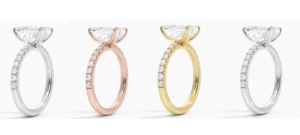
On the left is white gold, followed by rose, yellow, and platinum.
4. Cost Effective
Choosing a French or petite pave setting is a cost effective way to increase the total carat weight of your jewelry.
That’s because the price of a diamond doesn’t increase linearly as its carat weight increases. It’s exponential.
So a one-carat diamond costs more than two weighing 0.50 carats.
As an example, this four-prong solitaire ring in 14K white gold costs $400.
The vendor also lists a petite pave ring in 14K white gold, with 0.28 carats of accents, for $1,300.
That’s a $900 premium for that extra carat weight.
Let’s compare the price increase for adding 0.28 carats to the main diamond.
This one-carat diamond costs $5,521.
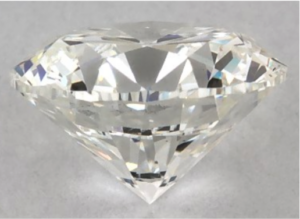
The vendor also sells ones that weigh 1.28 carats and earned the same color, clarity, and cut grades.
They are priced at $8,510 and $9,995.
One average, that’s a $3,732 jump in cost.
This example illustrates it’s far less expensive to add the carat weight to a French or petite pave setting compared to the center diamond.
Is French or Petite Pave Right For You?
If you’re comparing French pave versus petite pave, know their subtle differences.
Here’s some tips to help decide which is right for you.
Consider French pave if:
- The design of the V-shaped cutouts is appealing
- You want larger pave diamonds
- You’re willing to pay a slight premium compared to petite pave
Opt for a petite pave setting if:
- You want to maximize the visibility of the accents
- There’s a particular design you have in mind, and you aren’t concerned that options are limited compared to French pave
- The lower price for petite pave would allow you to put that savings into other areas of the piece
Explore a variety of settings, including variations such as micropave, U-cut, and bright cut.
But if you decide on one of the other two, you’ll have a ring with French or petite pave that has increased brilliance and is perfect for you.

Jacob Clarke
Jacob Clarke is the founder of TeachJewelry.com.
He earned an Applied Jewelry Professional Diploma from the Gemological Institute of America (GIA) and now brings you essential information about diamonds, settings, and more.
Jacob has consulted with leading jewelry brands, and his work has been cited in Clean Origin, Diamond Nexus and industry publications.
He's also a member of the International Gem Society.
He enjoys discussing jewelry with readers, so contact him with any questions at jacob.clarke@teachjewelry.com.

